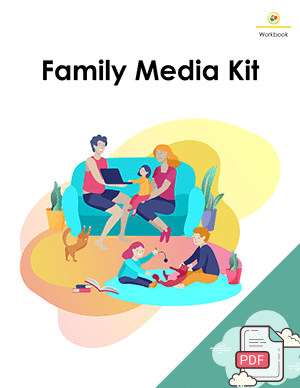Even though smartphones and other electronic devices are prevalent among children today, they don’t have to be for yours until you feel your child is ready. Media tips from the American Academy of Pediatrics recommend that children under the age of 18 months not have any interaction with digital media. But what about older children? I believe it’s up to you, the parent, to decide.
Why Wait to Introduce Media?
My oldest is 12 and she is still smartphone-free. But why did we decide to wait when electronic devices and smartphones are so commonplace with children? Here are the pros and cons of having a smartphone that we considered when making our decision.
Pros:
- There is a wealth of knowledge at your child’s fingertips. Anything can be found with Siri or Google.
- Multiple books can be downloaded and read without having to carry each book around.
- You can know where your child is at any time with location apps.
- You can be in contact/talk with your child at any time, and if they need to get ahold of you, they can.
- Your child can continue to socialize with their friends when they are not with them through social media and texting.
- You don’t have to hear “I’m bored.”
Cons:
- Your child can find anything, even things you don’t want them seeing or being exposed to.
- Being online opens the door to predators being able to find your child.
- Once something is posted on social media or sent via text, it is out there and can be shared with someone your child did not intend to share it with, even if they post it temporarily (screen shots can be taken).
- Electronic devices have a tendency to suck people in and waste time. Your child may only want to stare at their device for hours on end.
- Staring at an electronic device for hours on end is not good for the eyes.
- Your child will not interact with the family or engage with the family as much as they did prior to getting a device.
- Your child will not be as active as they used to be.
- Your child will not reach the point where they are bored, which is the point when their imagination comes into play and new ideas can develop.
For us, it really boiled down to one thing: She doesn’t get dropped off and left somewhere (other than school) where a cell phone makes sense for safety. Because of this, we decided a cell phone was not needed now.
Discuss Media Options with Your Child
But how does our 12-year-old feel about not having a smartphone? She actually supports it (surprise, I know!). She found out about the Wait Until 8th pledge at school and came home asking to sign it. That doesn’t mean she doesn’t want a cell phone or isn’t highly anticipating getting one. It just means she understands a smartphone can be more distracting than a basic cell phone and she sees the benefits of waiting.
Instead of spending time on a smartphone, she’s been spending her home time crafting (and made over $300 at a holiday craft fair), reading, being outside, spending time with the family, and focusing on schoolwork. Because she was involved in the discussion, it’s been much easier to wait.
What about friends and peer pressure, though? I think if you are open and honest with your child about the reasons and are willing to work with them to find a solution you are both happy with, you can work around the peer pressure. Most of my daughter’s friends don’t have smartphones yet, but the majority of them do have tablets.
Although we didn’t feel she needed a tablet (as there isn’t much difference between them and a smartphone besides the calling features), we did recognize her desire to connect with her friends outside of school.
So, we allowed her to get an email address (which she checks on the family computer). And even though we said no to the tablet, we also recognized her desire to have some sort of device of her own and talked with her about what she was looking for. We were able to come to an agreement on an MP3 player and a Kindle (even though my husband and I both prefer actual books).
My husband and I held firm, though, in our decision of nothing that had apps or games, like smartphones and tablets have. She ended up purchasing an MP3 player that only has the capability to listen to music, audiobooks, and the radio. For the Kindle, we decided a Kindle Paperwhite was the best option and have allowed her to be on Goodreads. But both of these devices, being on Goodreads, and the email address came with ground rules that we agreed on prior to her getting them. So far, so good.
Agreeing on the Ground Rules
With her entering seventh grade next year and the fact that just about everyone in junior high has a smartphone and a lot of socializing happens via text, we know a cell phone is in her future. But it won’t be a smartphone, it will just be a basic cell phone. We want to ease into things and have many, many more discussions about social media before handing her a smartphone. (This HuffPost article explains some of the social media concerns we have and why we are not just giving free rein.)
I’m sure many of the discussions will focus on the peer pressure she’s feeling to have a smartphone. But we will continue to be open and honest with her as parent leaders, remind her why she decided to wait on a smartphone as well, and be willing to work with her to find a solution that we are all happy with, and I know we will find a way to deal with the peer pressure.
Before that basic cell phone hits her hands, though, we’ll be deciding on ground rules and developing a media plan. Unsure how to do that? Here are some things to think about and discuss with your child when trying to decide on your ground rules and coming up with a media plan of your own:
- What types of media does your family use?
- What devices does the family have and why?
- What rooms are media allowed in?
- How much time can be spent on media?
- Are there any times that are media-free?
FEATURED RESOURCE
FAMILY MEDIA STRATEGY
Free Questions and Prompts to Develop Your Strategy Today!
To read more about creating a media plan, read iRules: What Every Tech-healthy Family Needs to Know About Selfies, Sexting, Gaming, and Growing Up by Janell Burley Hofmann or take a look at the media plan from the American Academy of Pediatrics that you can fill out online.
The bottom line is: Technology is valuable and can be a useful tool as long as your child learns how to manage it. And you play a vital role in modeling and teaching that management. You are also the only one who knows your family’s situation and can decide whether or not an electronic device is appropriate or at what point your child is ready for one. Even if your child does not agree with you, being the family leader and having some difficult conversations with them about media use and devices can result in a solution that everyone can live with.
What To Do Next
1. Read more in the blog:
The Family Wisdom Blog shares valuable ideas across diverse topics.
2. Explore the Printables Library:
Our printables library is filled with must-have activity ideas, checklists, guides, and workbooks.
3. Subscribe to Our Newsletter:
Sign up for our newsletter for parenting tips to help you create the family team you've always wanted.
Carolyn Savage
Carolyn is a writer, proofreader, and editor. She has a background in wildlife management but pivoted to writing and editing when she became a mother.
In her "free time" she is a 4th Dan (degree) Kukkiwon certified black belt in Taekwondo, loves learning to craft from her enormously talented children, and then teaching what she's learned to her enormously talented grandmother. Read full bio >>






